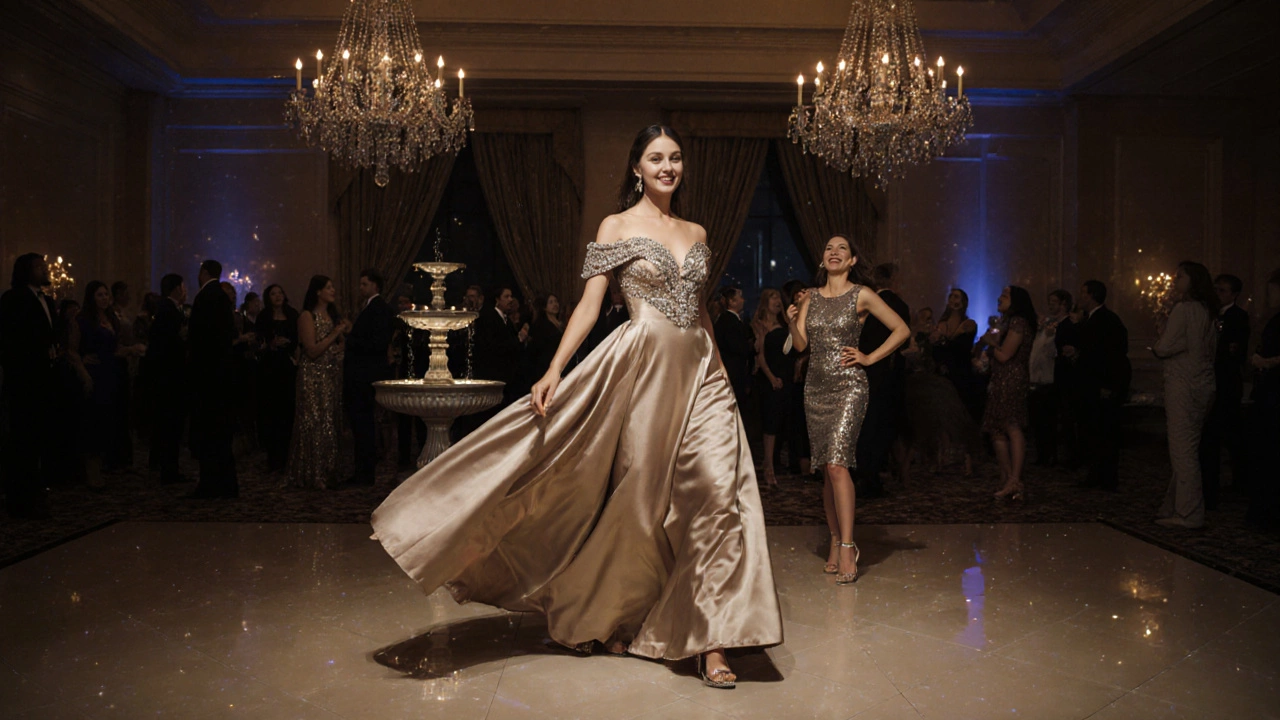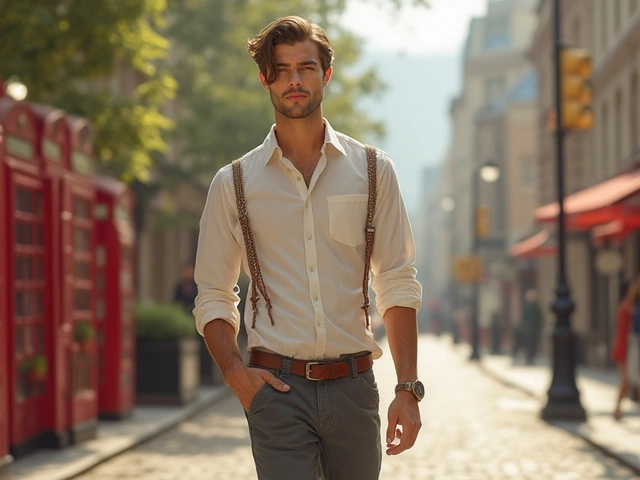What Is the Difference Between a Cocktail Dress and an Evening Gown?

- Cleo Fairchild
- 15 November 2025
- 0 Comments
Dress Code Checker
What's the right formalwear for your event?
Answer these quick questions to determine if you should wear a cocktail dress or evening gown
Choose this dress
Ever stood in front of your closet the night before a wedding, gala, or work party, holding two dresses that look suspiciously similar - one labeled cocktail dress, the other an evening gown - and wondered if it really matters which one you pick? It does. Getting this wrong isn’t just a fashion faux pas; it can make you feel out of place, underdressed, or worse - like you’re trying too hard.
Length Tells the Story
The easiest way to tell them apart? Look at the hemline. A cocktail dress typically hits anywhere between the knee and mid-thigh. Think of it as the sweet spot between casual and formal. It’s the dress you wear to a birthday dinner at a fancy restaurant, a holiday office party, or a rooftop cocktail bar. It’s meant to be elegant but not overwhelming.An evening gown, on the other hand, is floor-length. Always. No exceptions. It drapes to the ground, sometimes pooling slightly at your feet. You’ll see these at black-tie events: award ceremonies, formal galas, opera openings, or high-society weddings. The length isn’t just about tradition - it’s a signal. This dress says: I’m here for the grand occasion.
Fabric and Detail: Subtlety vs. Drama
Cocktail dresses lean toward clean lines and restrained embellishment. You’ll find them in silk, lace, crepe, or structured satin. Maybe a bit of beading around the neckline, or a subtle slit. They’re designed to be stylish without shouting. A little black dress? That’s a cocktail dress. A sequined mini with a plunging neckline? Still a cocktail dress - if it doesn’t drag on the floor.Evening gowns go all in. Think heavy silk satin, velvet, tulle, or chiffon layered over a structured underlay. Embellishments aren’t optional - they’re expected. Beading, embroidery, crystals, feathers, or even hand-painted details. The neckline might be a deep V, off-the-shoulder, or a dramatic illusion back. The goal? To turn heads without saying a word.
When to Wear What
Let’s get practical. If you’re invited to a wedding with black-tie optional on the invite, you’re being given permission to choose. But here’s the rule: if the event starts after 6 p.m. and is held in a hotel ballroom, a grand hall, or a museum, go for the evening gown. If it’s a dinner party at someone’s home or a trendy bar with live jazz, a cocktail dress is not just fine - it’s ideal.Corporate holiday parties? Cocktail dress. Charity galas with silent auctions and string quartets? Evening gown. Graduation balls? Evening gown. Birthday dinner with friends at a Michelin-starred restaurant? Cocktail dress. The dress doesn’t just match the event - it matches the energy of the space.

Shoes and Accessories: The Silent Rules
Your shoes should match the dress’s formality. With a cocktail dress, you can wear heels - stilettos, block heels, even embellished flats. Clutch bags, statement earrings, a thin bracelet - all fine. You’re aiming for polished, not theatrical.With an evening gown, you go full elegance. Heels are non-negotiable - usually 3 to 4 inches, strappy or sleek. No flats, no ankle boots, no sneakers. Your bag? A small, structured clutch - nothing that looks like you’re carrying groceries. Jewelry should be refined: pearl drops, diamond studs, a delicate chain. Avoid chunky necklaces - they compete with the gown’s neckline. And please, leave the oversized tote at home.
History Behind the Rules
The cocktail dress emerged in the 1920s, right after Prohibition. Women started dancing in speakeasies and needed something that let them move, yet still looked refined. Coco Chanel and Jean Patou popularized shorter hemlines and simpler silhouettes. It was rebellion dressed in elegance.The evening gown? That’s older. Rooted in 18th-century aristocracy, where royalty wore floor-length gowns to court events. By the 1950s, Hollywood stars like Audrey Hepburn and Elizabeth Taylor made evening gowns the symbol of high society glamour. These weren’t just clothes - they were armor for moments that mattered.

Common Mistakes People Make
One of the biggest errors? Wearing a long dress to a cocktail event. It looks like you’re trying to outdress everyone. It’s not impressive - it’s awkward. Likewise, showing up in a short dress to a black-tie gala? You’ll feel exposed, even if you’re perfectly dressed for a party.Another mistake? Thinking “formal” means “covered up.” Evening gowns often show skin - back, shoulders, legs - but they do it with intention. A cocktail dress might show more leg, but it’s balanced by simplicity. It’s not about how much skin you show - it’s about how you show it.
What If You’re Not Sure?
If the invitation doesn’t specify, ask the host. Or check the venue. Is it a ballroom? A yacht? A cathedral? Then go for the gown. Is it a rooftop lounge? A chic bistro? Stick with the cocktail dress.Still unsure? Look at the time. After 6 p.m.? Formal. Before 6 p.m.? Semi-formal or cocktail. That’s the old-school rule - and it still works.
Modern Flexibility
Today, rules are looser. You’ll see women in sleek, knee-length satin gowns at black-tie events. You’ll see men in tuxedos without ties. But that doesn’t mean the distinction between cocktail and evening wear is gone - it’s evolved. The key now is context. A dress that looks like an evening gown but is shorter? That’s a “long cocktail.” A gown with a slit and bare shoulders? Still an evening gown if it hits the floor.Ultimately, the difference isn’t just about fabric or length. It’s about respect. Wearing the right dress shows you understand the event’s tone. It says you care enough to get it right - not because you’re trying to impress, but because you value the moment.
Can I wear a cocktail dress to a wedding?
Yes - but only if the wedding invitation says "cocktail attire" or "semi-formal." For traditional or black-tie weddings, an evening gown is expected. If in doubt, check the venue and time. A daytime wedding with garden vibes? Cocktail dress is perfect. An evening wedding in a grand hall? Go for the gown.
Is a long dress always an evening gown?
Not necessarily. A dress that’s floor-length but simple, made of cotton or jersey, with no embellishment, might be called a "long cocktail" or "maxi dress." True evening gowns have structure, luxurious fabric, and intentional detailing. Length alone doesn’t make it formal - it’s the combination of fabric, cut, and design.
Can I wear an evening gown to a birthday party?
Only if it’s a very formal celebration - think 50th birthday at a luxury hotel with a live orchestra. For most birthday parties, even if they’re fancy, a cocktail dress is more appropriate. Wearing a full evening gown to a casual gathering can feel over-the-top and draw unwanted attention.
What’s the difference between a ball gown and an evening gown?
A ball gown is a type of evening gown - but with an exaggerated skirt. Think Cinderella: full, voluminous, often with a corseted waist and layers of tulle. Evening gowns are sleeker, more tailored. They can be mermaid, sheath, or A-line, but they don’t have the dramatic volume of a ball gown. Ball gowns are for debutante balls or royal events. Evening gowns are for modern galas.
Do I need to wear gloves with an evening gown?
No. Gloves were fashionable in the 1940s and 50s, but they’re not required today. In fact, they’re rarely seen at modern events. Unless you’re attending a vintage-themed ball or a very traditional ceremony, skip the gloves. They’ll make you look like you’re going to a tea party, not a gala.


